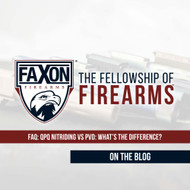FAQ: QPQ Nitriding vs PVD, What is the difference?
Posted by Faxon Firearms Staff on May 11th 2023
QPQ Nitriding vs PVD, What is the difference?
When it comes to improving the performance and durability of metal components, surface treatment processes such as QPQ nitriding and PVD coatings are often used. Both processes provide excellent wear resistance, corrosion resistance, and hardness to metal components, but they differ in their application, properties, and cost.
QPQ nitriding is a thermochemical process that involves heating the metal component in a nitrogen-rich environment (in our case, molten salts) and then cooling it rapidly with a quenching medium, such as oil or water. During the process, nitrogen atoms diffuse into the surface of the metal component, forming a hard and wear-resistant nitride layer. The nitride layer not only forms on the surface of the material but also penetrates the underlying substrate to form a diffusion zone. As a result, QPQ nitriding can provide a more durable and long-lasting surface treatment option compared to some line-of-sight coatings.
One of the main advantages of QPQ nitriding is that it can improve the fatigue strength of the metal component, making it less prone to cracking or failure under stress. Additionally, QPQ nitriding can enhance the corrosion resistance of the metal component, making it more resistant to the effects of moisture and other contaminants.
QPQ is not a line-of-sight coating. This means that all aspects of the part are treated, including blind holes and the inside bore of an item. This makes it a favorable coating for firearms barrels (specifically rifle barrels) as it treats the more wear prone bore of the barrel for a longer useful life.
QPQ nitriding is often used for large metal components, such as firearm barrels, automotive parts, and industrial equipment. It tends to be less expensive than PVD due to its simpler process and equipment requirements.
PVD (Physical Vapor Deposition)
PVD or Physical Vapor Deposition is a physical process that involves depositing a thin film of material onto the surface of the metal component through vacuum deposition. PVD coatings can be highly customizable, allowing for precise control over the thickness and composition of the coating, which can help to tailor the coating to specific application requirements.
PVD coatings can provide a hard and wear-resistant layer on the surface of the metal component, which can improve the durability and lifespan of the component. Additionally, PVD coatings can also provide additional benefits such as improved lubricity and reduced friction, which can enhance the performance of the component.
PVD coatings are commonly used in a variety of applications, including aerospace, medical devices, and cutting tools. They can be highly wear-resistant and corrosion-resistant, making them suitable for a wide range of applications.
The choice between QPQ nitriding and PVD coatings will depend on several factors, including the specific application, the quality of the surface preparation and coating application, and the materials used in the process. In general, QPQ nitriding tends to be a more durable surface treatment than some types of PVD coatings because it forms a diffusion zone that penetrates the substrate, creating a more durable and wear-resistant layer. However, PVD coatings can also provide excellent wear and corrosion resistance, and they offer greater flexibility in terms of customizability and application.
In conclusion, both QPQ nitriding and PVD coatings can provide excellent surface treatment options for metal components, and the choice between the two will depend on the specific application requirements and the materials used in the process. It's important to work with a qualified coating applicator or testing laboratory to select the appropriate surface treatment process and ensure that the coating meets the necessary specifications and performance requirements.

